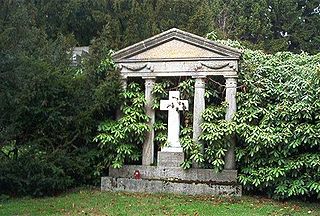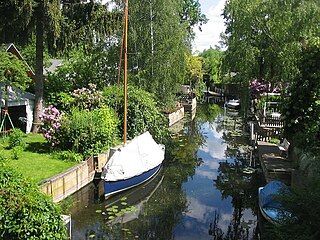
The Friedrichsfelde Central Cemetery is a cemetery in the borough of Lichtenberg in Berlin. It was the cemetery used for many of Berlin's Socialists, Communists, and anti-fascist fighters.

Schöneberg is a locality of Berlin, Germany. Until Berlin's 2001 administrative reform it was a separate borough including the locality of Friedenau. Together with the former borough of Tempelhof it is now part of the new borough of Tempelhof-Schöneberg.

Friedenau is a locality (Ortsteil) within the borough (Bezirk) of Tempelhof-Schöneberg in Berlin, Germany. Relatively small by area, its population density is the highest in the city.

Städtischer Friedhof III is a cemetery in the Friedenau district of the borough of Tempelhof-Schöneberg in Berlin, Germany. Buried here are Ferruccio Busoni (1866–1924), Marlene Dietrich (1901–1992) and Helmut Newton (1920–2004).

Platz der Luftbrücke is a Berlin U-Bahn station located on the U6. It is located under Platz der Luftbrücke and the south end of Mehringdamm on the border between Kreuzberg and Tempelhof, near the former Tempelhof International Airport, and is now named for the square there with its memorial to the victims of the Berlin Airlift.
The Greater Berlin Act, officially Law Regarding the Creation of the New Municipality of Berlin, was a law passed by the Prussian state government in 1920, which greatly expanded the size of the Prussian and German capital of Berlin.

The Friedhof Heerstraße cemetery is located at Trakehnerallee 1, district of Charlottenburg-Wilmersdorf in Berlin, Germany, to the east of the Olympiastadion. It covers an area of 149,650 square meters.

Ohlsdorf Cemetery in the Ohlsdorf quarter of the city of Hamburg, Germany, is the biggest rural cemetery in the world and the fourth-largest cemetery in the world. Most of the people buried at the cemetery are civilians, but there is also a large number of victims of war from various nations. The cemetery notably includes the Old Hamburg Memorial Cemetery with the graves of many notable Hamburg citizens.

The Dorotheenstadt Cemetery, officially the Cemetery of the Dorotheenstadt and Friedrichswerder Parishes, is a landmarked Protestant burial ground located in the Berlin district of Mitte which dates to the late 18th century. The entrance to the 1.7-hectare (4.2-acre) plot is at 126 Chaussee Straße. It is also directly adjacent to the French cemetery, established in 1780, and is sometimes confused with it.

The Protestant Kaiser Wilhelm Memorial Cemetery is a burial ground in the Westend district of Berlin with a size of 3.7 hectares. The cemetery is under monument and cultural heritage protection.

The Protestant Luisenfriedhof III is a cemetery in the Westend district of Berlin. The cemetery is under monument protection.

Dorit Schmiel was a German seamstress who became the thirteenth known person to die at the Berlin Wall. Schmiel was fatally shot by East German border guards while attempting to escape from East Berlin to West Berlin with a group of friends, including her fiancé. Schmiel was one of only eight women to die at the Berlin Wall, and at 20 years-old was the second youngest woman victim.

Feuerhalle Simmering is a crematorium with attached urn burial ground in the Simmering district of Vienna, Austria. It lies at the end of an alley, directly opposite Vienna Central Cemetery's main gate.

The St. Peter and Paul cathedral is the largest medieval church in Brandenburg an der Havel, Brandenburg, Germany. Construction began in 1165 as a Romanesque Saalkirche. It was expanded several times to a three-aisled Brick Gothic basilica. The cathedral is commonly designated “the cradle of the Mark Brandenburg” for its historic significance. The patron saints are Peter and Paul.

The Westhafen is Berlin's largest inland port, located in the district of Moabit.

The Treskow family burial ground is a historic landmark in Berlin, Germany. It was established in 1821 by Carl Sigismund von Treskow for his family, a branch of the von Treskow noble family, and is located in the park of Friedrichsfelde Palace in the Friedrichsfelde district.

Preußenpark, also known as Thai Park or ThaiPark Berlin, is a public park in the Berlin quarter of Wilmersdorf, which belongs to the district of Charlottenburg-Wilmersdorf. With a size of 55,000 m2, the park is one of the smaller parks in Berlin. North of Fehrbelliner Platz, Preußenpark extends between Brandenburgische Straße and Württembergische Straße to Pommersche Straße.

The Holy Cross Evangelical Lutheran Cemetery is a historic Lutheran burial ground in Mariendorf district of Berlin. The cemetery is owned and operated by the Evangelical Church in Berlin, Brandenburg and Silesian Upper Lusatia.

Tiefwerder encompasses both a village and a Werder along the Havel River in the Berlin district of Spandau. While the village of Tiefwerder, along with the neighboring southern port of Spandau, falls under the jurisdiction of the district of Spandau, the surrounding forested areas, meadows, and water areas of the Werder are administratively part of the district of Wilhelmstadt.


















